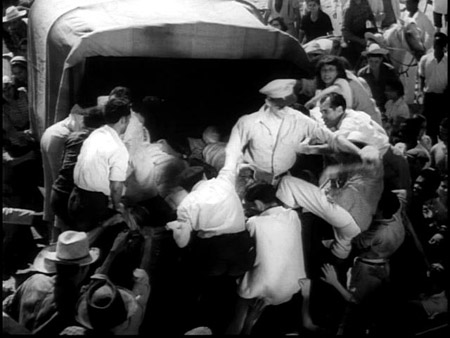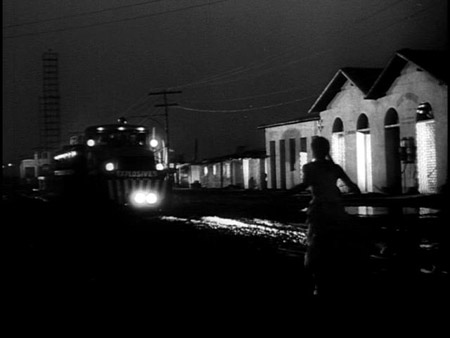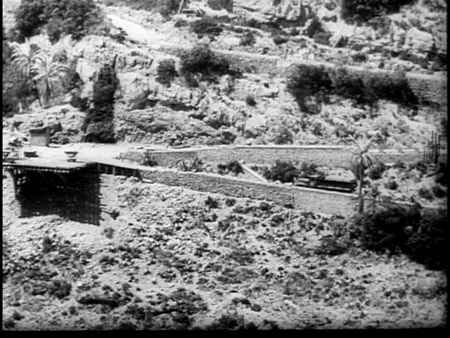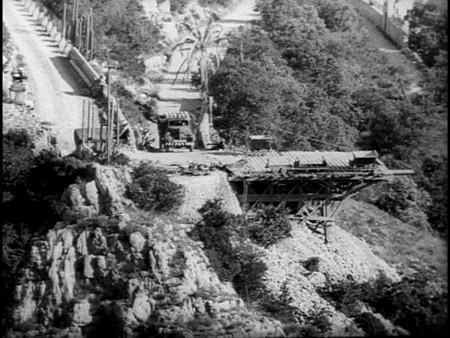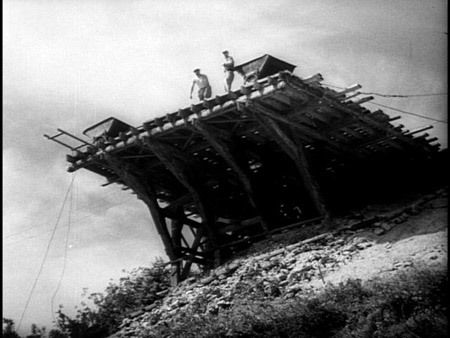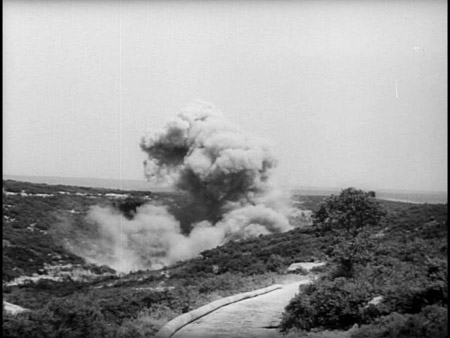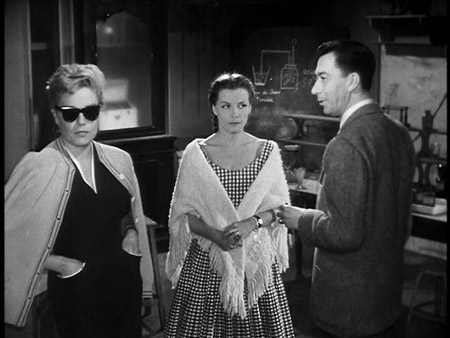Time Bandits, 1981, directed by Terry Gilliam, written by Michael Palin and Terry Gilliam.
In 1980, Terry Gilliam was depressed because he couldn't get Brazil out of development. To get his mind off things one weekend, he sketched out an outline for what became Time Bandits. The movie feels kind of slapdash and ramshackle; it's a minor film, but it doesn't take itself too seriously, and it's a lot of fun. Childhood is a pretty weird time, and children need pretty weird stories to help them navigate it. The whole thing feels like the kind of story you made up at nine or ten; old enough to have a lot of strange things floating around in your psyche but still prepubescent.
Craig Warnock plays Kevin, a boy of about ten who spends his time reading books about ancient wars and is largely misunderstood and ignored by his parents. Fortunately for Kevin, his room is the location of a hole in space-time. So he has a way out of the boredom of suburbia that wasn't available to most of us: running away with a gang of dwarves who are travelling through time stealing anything of value they can get their hands on. I had to settle for legos, but Kevin gets the larcenous dwarves. That's my life. Oh, they're also being chased by both the Supreme Being and the Evil Genius, neither of whom are people you want mad at you.
The two smartest moves Gilliam makes in this movie are making his main characters dwarves, and making his main characters jerks. They're incredibly greedy, they don't care for anyone but themselves, they're going down the relatively dumb road of defying gods at both ends of the spectrum, and they keep kidnapping a ten-year-old. But they're dwarves, so their hostility and avarice are kind of endearing. Here's the whole bunch:
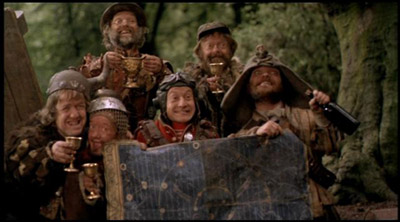
Notice the costumes, made from whatever they could scavenge from various time periods. Yes, one of them has a colander for a helmet.
The map they're holding in the picture shows all of the holes in space time that they're using to get from place to place. Once Kevin runs off with these guys, the first half of the movie is a tour of various historical time periods, like a better, stranger version of Bill and Ted's Excellent Adventure. The best sequence is also the first: they visit Napoleon during the battle of Castiglione. Rather than leading his troops, Napoleon (played brilliantly by Ian Holm) is captivated by a Punch & Judy show; when the puppeteer is shot, Napoleon demands more entertainment. The theater owner brings out act after act, but nothing satisfies. Napoleon wants "more of the funny show, the little puppets hitting each other. That's what I like! Little things! Hitting each other!"
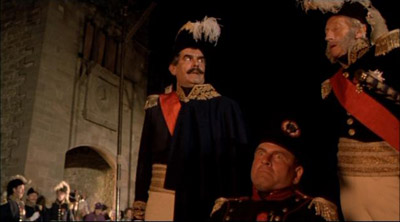
Napoleon, looking unhappy. The generals in this shot are standing on boxes to make Ian Holm look even shorter.
Of course you have to imagine Ian Holm's terribly inauthentic French accent to really make the scene complete. Better still is the lengthy, drunken speech he gives about the heights of various world leaders:
Alexander the Great? Five feet exactly. Isn't that incredible? Alexander the Great, whose empire streched from India to Hungary...one inch shorter than me. Oliver Cromwell...the only man with any guts in British History...not a big man at all.
Also notable is John Cleese's Robin Hood, a performance loosely inspired by the appearances of minor British royalty at soccer matches. He doesn't do anything except appear, shake everyone's hand, and make inane small talk. He's only on screen for two minutes or so, but he's great.
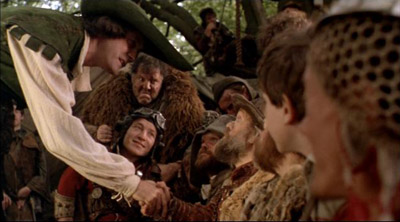
The best thing about children's movies, I think, is that you're under no obligation to make the bad guys bad for a reason. They don't have to have anything to gain from their actions, they don't have to have had a bad childhood or any backstory; they're just bad. I'm not really sure what inspired David Warner, who plays the Evil Genius (really, that's his character's name!) but he's great fun to watch. He's very campy, and he's not just a fallen angel, he's also a technocrat. Here's his critique of God:
God isn't interested in technology. He cares nothing for the microchip or the silicon revolution. Look how he spends his time... forty-three species of parrots! Nipples for men!
...
If I were creating the world I wouldn't mess about with butterflies and daffodils. I would have started with lasers. Eight o'clock, Day One!
Better to reign in hell than serve in heaven, as long as hell has digital watches. As you can see, some of the anti-technology elements that show up in Brazil are already present in Time Bandits. As are the creepy masks; two examples:
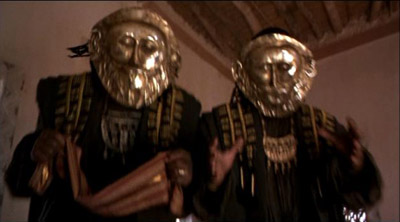
Despite their appearance, these are good guys.
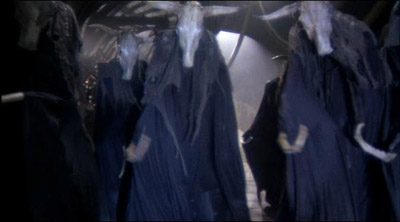
These guys, on the other hand? Not so good.
Those horrific cow-head things are the Evil Genius's minions. They shoot fireballs from their heads and are roughly eight feet tall. While David Warner may be campy, these guys are genuinely disturbing and threatening.
Structurally Time Bandits is very episodic and loose, as you would expect in a movie that jumps from historical period to historical period. As a result, the strong points are individual scenes, not the movie as a whole. I hadn't seen it since I was a kid. I could have told you the basic story, and I remembered Ian Holm's Napoleon, but completely forgot Sean Connery was in the movie. Which should tell you whose performance is more memorable, but also how loose the movie is; cutting away an entire section doesn't make the story fall apart. Anyway: if you're a fan of Terry Gilliam, you'll find a lot in this film you'll like, but don't expect brilliance. Time Bandits is just a low-key, enjoyable movie. You know, for kids.
Randoms:
- It's hard to see it in the stills above because, except for the Robin Hood one, there isn't much reference, but Gilliam puts the camera at about four feet off the ground for virtually every shot, so that things are shot from a kid's eye view. The effect is subtle but noticeable; adults look more grotesque and kids and dwarves less so.
- The shot of the Titanic sinking is from A Night To Remember, although it has been colorized. This makes Time Bandits the first movie in the Criterion Collection to include stock footage from another movie in the collection.
- Two of the six actors who played the dwarves are now dead. Jack Purvis was crushed by a car, and David Rappaport shot himself. As you can imagine, this makes for a cheery section of the commentary track.
- Although the Criterion Collection's website says that Time Bandits is presented in its original aspect ratio of 1.85:1, you can see from the stills above that it's not; it's actually about 1.80:1. I cropped few pixels on the left and right sides of the frame for those stills as well (I believe they were left black to protect against overscan on CRT monitors). I'm not sure if this was masked incorrectly or what, but what I do know is that on a 16:9 TV you end up losing a little of the image at the top and bottom when you zoom in correctly. (The math on that doesn't work, quite; it would have to be less than 1.78:1 for the image to be cropped. I'm trying to figure out why. It's possible the scaler on my TV is wrong). Anyway, the point is, anyway you look at it, this wasn't transferred at 1.85:1.
- This may be the only children's movie ever made that alludes to Petronius's Satyricon. This, and The Brave Little Toaster.
